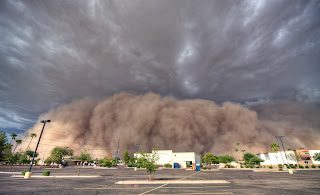Could COVID-19 Be Enabling Valley Fever in the US Southwest?
As if our friends in India aren't having enough problems with the COVID-19 wave there, there is a new problem. This one isn't a complication of the disease per se but a result of its treatment.
India is seeing a huge spike in cases of mucormycosis, a.k.a Black Fungus, in humans. According to a report, India has had a handful of cases over the last decade, but is suddenly seeing tens of thousands of infections.
Experts think this is happening because shortages of oxygen are causing physicians to prescribe more corticosteroids to people with COVID-19 (you can also buy these drugs without a prescription in India). Experts reason that these drugs are suppressing inflammatory responses and are thereby creating opportunities for the fungus to take hold.
The disease happens when people inhale spores of a mold that lives in the ground and decaying organic material. According to the CDC, infections can happen in the lungs and gastrointestinal tract, but the infections being reported in India are rhinocerebral (in the sinus and brain).
The disease has a horrifying set of symptoms. They include facial deformity and pain, headache, nasal congestion, loss of vision or pain in eyes, altered mental state or confusion, swelling in cheeks and eyes, toothache, loosening of teeth, and black crusts in the nose. Yikes!
Valley Fever
As an Arizonan, hearing this made me wonder whether something similar could be happening with a fungal infection that is not uncommon around here, coccidiomycosis, a.k.a. Valley Fever. It too results from inhalation of spores from a fungus that lives in the ground. These tend to be stirred up during our ubiquitous dust storms.
If steroid treatments for COVID-19 in India create opportunistic Black Fungus infections there, shouldn't they do the same for Valley Fever here? Has there been a spike in cases over the last year?
The CDC just published a study on this matter. It turns out this is a very difficult question to answer. Why? Because both COVID-19 and Valley Fever are infections of the lungs and have similar symptoms. According to the study:
Both diseases can cause dry cough, muscle aches, headache, fatigue, and difficulty breathing. ... Attributing coccidioidomycosis symptoms to COVID-19, whether presumed or laboratory-confirmed, might preclude coccidioidomycosis diagnosis in patients with monoinfections or co-infections. In addition, underutilization of healthcare services during the COVID-19 pandemic might result in further delays in the testing and diagnosis of coccidioidomycosis.
So, the same thing happening in India with Black Fungus could be happening here with Valley Fever. One might also think it should be happening here, because corticosteroids are in use here as a COVID-19 treatment too. But it seems it's impossible to tell because of the similarities in symptoms and they way the pandemic is disrupting the health care system.
Image by Saija Lehtonen



